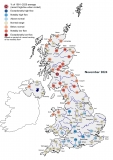Submitted by Steve Turner on
August was a mild month of notable contrasts; unseasonal persistent wet and occasionally very windy weather more typical of autumn featured either side of heatwave conditions. The culmination of a wet summer, August rainfall was substantially above average across most of the UK, generally exceeding 150% of average away from northern Scotland, Kent and the East Anglian coast. Soil moisture deficits (SMDs) reduced substantially; August soils were wetter than average, a remarkable transition from near-record dry soils in late spring. River flows were above average across a broad swathe from the south-west to the north-east, and notably to exceptionally high in Wales and Northern Ireland. Near-average flows characterised the south-east whilst river flows were below normal in the far north of Scotland. Groundwater levels generally continued to decline in the main aquifers, with some exceptions mainly in the west. Reservoir stocks for England & Wales increased substantially and returned to above average for the first month since late winter. Some reservoirs in south-west England were moderately below average and stocks at Ardingly fell by a quarter of capacity to 38%, a new August minimum in a series from 1988. Notwithstanding the localised low reservoir stocks and groundwater levels, the summer’s wet weather has bolstered UK water resources overall. With reservoir stocks generally healthy approaching the winter half-year, attention turns to outlooks for autumn rainfall to determine the timing and magnitude of groundwater recharge, which will be influential for water resources in the south-east for 2021.



